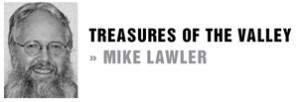Last week we heard of the raid on the Hardyman home by 20 misguided locals wearing American Legion hats who had, according to their statements, convinced themselves that this meeting of the Democratic Club was planning the overthrow of the U.S. government. No one got hurt, and the scheduled meeting continued, but our homegrown leftist Hugh Hardyman wasn’t about to let it rest.
The next morning, Hardyman, with news reporters in tow, was down at the Montrose Sheriff Station to press charges, alleging that the intruders had been armed and had “roughed up” his guests. Next stop was the DA’s office in L.A., where, according to the CV Ledger, the incident began to flicker onto the national news. As the heat began to rise, the raiding party sheepishly turned themselves in, and the participants were revealed to have indeed been members Glendale American Legion Post 127, including the Post Commander. They were all charged with breaking up a lawful meeting and disturbing the peace, save for one participant – a former publisher of the Glendale News Press who was charged with battery.
Hardyman continued to spin the confrontation, and a week later organized a mass meeting at the Glendale Civic Auditorium to condemn the incident, featuring nationally prominent political figures. The episode was even discussed on the floor of Congress.
However when the trial concluded a month later, of the 20 charged, only 13 were convicted, 11 receiving $25 fines or five days suspended sentence, and two, including the News Press publisher, receiving $250 or 125 days. “Oh, hell no!” was Hardyman’s attitude, and the lawsuits began to fly.
According to the L.A. Times, the first stop was the U.S. District Court, where allegations of civil rights violations were dismissed. Next to the U.S. Circuit Court where the dismissal was reversed, and third to Superior Court which found in favor of the Legionnaires. Finally in 1951, Hardyman pushed his case all the way to the U.S. Supreme Court. The Supreme Court denied Hardyman’s claims of civil rights violation in a 6-to-3 decision, stating that the Civil Rights Act did not cover such privately instituted damage suits. Justice Jackson spoke for the majority, calling the incident “a lawless political brawl, precipitated by a handful of white citizens against other white citizens.” He went on to say that, “The facts alleged fall far short of a conspiracy to … deny equality of rights under the law…”
As such, the Battle of El Moreno Street ended with a whimper, but Hardyman’s penchant for making headlines was still on a hot streak. In 1952 (mid-Korean War) La Crescenta’s Hugh Hardyman, again per the L.A. Times, traveled to Red China to join the Chinese in condemning the United States for using germ warfare on North Korea. In fact, confessions had been obtained from captured U.S. pilots confirming they had participated in dropping plague and cholera-infected insects, and Hardyman toured other Communist countries, issuing the same condemnation. Interestingly, that allegation still rages across the internet today.
When Hardyman returned to La Crescenta, the U.S. government turned up the heat on him. In 1955 he was called before the infamous House Committee on Un-American Activities, where naturally he plead the Fifth. He did however affirm that he was not and never had been a member of the Communist Party, and repeated his allegations that the U.S. had waged germ warfare against North Korea. According to their annual report for 1955, the Committee gave the Justice Department the green light to prosecute Hardyman for falsifying his passport, and to explore whether he could be prosecuted for treason. At this point we lose track of Hardyman, but local rumor has it that he made himself scarce, possibly in Mexico. He died in 1960.
Hardyman’s spirit lives on at the First Unitarian Church of Los Angeles, where Nobel Prize winning scientist Linus Pauling memorialized his friend and fellow activist by building the Hardyman Center. Hardyman’s house in the 2300 block of El Moreno slumbers today, virtually unchanged since its brush with national fame in 1947.

